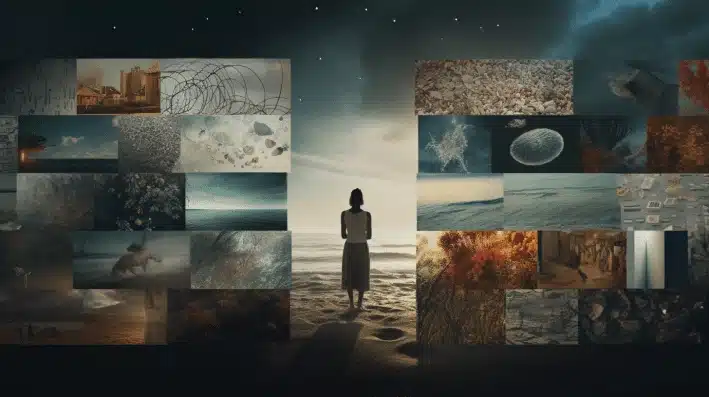The savvy pros at Bay Leaf Digital don’t just help companies market new technologies; we embrace them. We constantly seek out and apply innovative tools that help us do our jobs by streamlining our work and amplifying our strategies. We recently wrote about how to use ChatGPT for marketing. This brings us to Midjourney for marketing, a revolutionary AI-powered text-to-image generation platform redefining visual content creation. Over three-quarters of marketers are already using ChatGPT to some degree, but few are complementing that work with AI-generated images. Only 23% of Midjourney’s 14 million registered users are using the tool in a professional capacity.
Unlike traditional stock photo libraries, Midjourney for marketing allows you to create tailored, brand-aligned images that deeply resonate with your audience. Even better, it does so nearly instantly without compromising quality. The platform’s AI algorithms are designed to understand the context of your text, helping you create relevant and visually appealing images with just a few keystrokes. Midjourney is an easy-to-use asset that will enrich your content and captivate your audience in new and meaningful ways. Whether you are a new marketer or you have decades of experience behind you, cultivating the skills you need to leverage Midjourney is an opportunity for you to stand out from the crowd.
How to Use Midjourney to Create Images
With its ability to create a wide range of compositions in styles from simplistic to abstract. Midjourney turns your words into images. You can use Midjourney for marketing to creatively bring concepts to life with use cases like:
- Brand images for blogs, websites, ad campaigns, and more.
- Clip art packs for infographics.
- Images to replace uninspired stock photos.
Just look at what Midjourney created when we asked it to imagine its own self-portrait:

When we asked it what a Midjourney looks like, we got this:

There are a few limitations you should know about before beginning. First, Midjourney is not a large-language model (LLM). It does not understand writing words or numbers, and you should not include these details in your prompts. While we prefer the images generated by Midjourney, DALL-E 3 and other platforms will give you better results when you need to incorporate text. The software also cannot recognize hex codes or Pantone colors, so you’ll have to do your best to describe what you’re envisioning with words. Some users have found success by referring to Werner’s Nomenclature of Colors. Finally, remember that, like all AI, Midjourney is evolving even as we use it. Always check your output because the platform can have difficulty with details. For example, its rendering of human features is sometimes inaccurate, as in the image below.

Imagine Images with Midjourney
Access to Midjourney requires a Discord login and a Midjourney subscription. With those in place, you’re ready to begin imagining. Exhaustive documentation of available Midjourney parameters can be found at https://docs.midjourney.com/docs/parameter-list. We’ve got some easy-to-use, color-coded prompts that you can copy and paste to get started but the sky’s the limit. The only boundary is your own imagination.
The basic prompt will begin with /imagine and can also include five other components, like this:
Medium, Style/Composition, Subject/Scene, Tune, Dash-Dash Parameters
Medium is your way of telling the AI what kind of image you’re looking for. Examples of mediums include Photograph, Illustration, Graphic Design, Watercolor, Painting, Sketch, and Lithograph.
Once you tell the AI what medium you want for the output, you’ve got to let it know what you want the output to look like. You can describe a cinematic or photographic camera angle, clarify a preferred style, or even name your favorite artist. Examples of style/composition prompts could include ideas like: Full-Body Shot, Close Up, Wide Angle Shot, Narrative-Driven Visual Storytelling, Candid Photography, Photorealistic, Pop Art, Steampunk, Pixar, or Tim Burton.
Below, you can see a Midjourney-generated portrait of Bay Leaf Digital Founder and CEO Abhi Jadhav in the style of Andy Warhol:

Now you’re ready to clarify the subject or scene you want Midjourney for marketing to imagine for you. Be as specific as possible. Tell the AI as much as you can about your vision. What does the subject of the image look like? What is the subject wearing? Doing? Don’t just ask for “person at work.” Instead, prompt the AI to create an image of an “older male teacher at the blackboard wearing an orange vest and eating a donut.” Avoid being too wordy in your prompts. If the prompt is too complex, the AI will decide what’s most important.
Other examples of Subject/Scene might include:
- A man in a park wearing a hat.
- A business professional laughing.
- A group of people looking at data.
- An old woman riding a bike on a trail.
- A small white dog chewing a tennis ball in a field of sunflowers.
Tune is your opportunity to further refine the image. You can specify time of day, season, weather, colors and more.
Finally, dash-dash parameters will help the AI generate the most specific output for you. This is where you might use –aspect ratio 16:9 for a horizontally formatted image, –aspect ratio 9:16 for a vertically oriented image, or –aspect ratio square. You can include a negative dash-dash parameter like –no hat or –no blue or –no smile. To create a photograph, we like –style raw. Want something really unusual? Use dash-dash weird followed by a number from 0 to 3000 (–weird [0-3000]). The bigger the number, the weirder the output!
When you put it all together, it might look like this:
/Imagine Photography, in the style of stock images, business professionals in an office, day light — style raw

Or like this:
/Imagine cartoon, in the style of pixar, dogs playing in a dog park, spring morning –style raw

Little matters more to marketers than the ability to deliver compelling, cohesive, and highly targeted content. AI tools like ChatGPT and Midjourney for marketing complement the skills and experience of any marketer. ChatGPT can help you craft nuanced, data-driven text that speaks directly to your target audience’s pain points and needs. Midjourney quickly boosts the effectiveness of that copy with contextually relevant and brand-consistent images. Used in tandem, these platforms will save you time, elevate your content, and boost engagement and conversion rates. Be patient with yourself as you learn and allow plenty of time to practice. Set aside a few hours and give them a try.
Every day, the expert team at Bay Leaf Digital leverages innovative technologies like ChatGPT and Midjourney for marketing to help B2B SaaS companies find the leads they need to scale. Is your company ready to partner with us and transform your marketing efforts? Schedule a conversation with us today.



